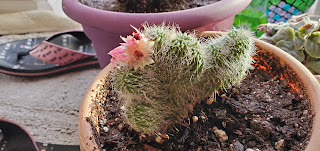This is a maintenance I had to do to a spare refrigerator. I am finding out not to ignore those light bulb that is broken. The light bulb should be replaced immedately on any refrigerator and or the light switch socket itself needs a replacement. This maintenace note is for Whirlpool Model GT1NHWXPQ00, 2004 model, Type C21TFA04
When the lightswitch goes bad, it seems to send mix signal to the refrigerator and the refrigerator might run continuously and or not run. Also cause immense amount of "frost" in the freezer compartment in my case.
It looked easy fix, but bit challenging. The wire is a bit short to strech out to reconnect to the new light switch purchased. (from Walmart)
And be sure to remove all the food instead of doing what I did. Taking a gamble that I can do this in 15 minutes. It took me about 45 min.
After removing the switch, I found out that I need to remove the cover, in order to have a good pull and a grip hold to the plugs.
The white wire was bit short and was difficult to reattach. It ends up being bent.
Push it back all the way in position and restore into the cover.

Plug the refrigerator back and test open and close the freezer compartment's door. If the light turns back on and shuts itself as the door touches the switch lever, the repair is complete.
For the other issue of water puddles within the refrigerator compartment below, the only thing I need to fix is dripping of water from the freezer to the refrigerator section to the top shelves, vegetable crispers, and bottom.
Next, remove the back panel's 2 screws that is holding the center air exchange channel - with 1/4 Inch Socket ranch. No need to remove the side screws. Inside, the bottom rail with 'drain hole' maybe plugged with ice and obstructing the normal drippage through the hose resulting in water dripping into the refrigerator compartment.via 2 squares and center air exchange duct. Water is supposed to escape from the drain hole into the water holding pan at the bottom of the refrigerator.
Parts are found in the back at the bottom covered by the cardboard.
The water in the pan normally evaporates from the heat generated during the cooling process of the refrigerator by a various parts. For complete removal of frozen ice in the drain hole and in the tube, entire defrosting of ice needs to be completed.
The Culprit - Frozen Ice blocking the water exit
Hair dryer helped to melt away some ice quickly
Finally found the hole to the water exit tube - blocked
Dripped in some Hot water to melt the ice blocking the water exit tube. *Be sure to gather the melting ice and hot water with towels.
After a cup of hot water - you will hear the ice dropped down through the tube to the bottom tray.
Drip more hot water through and you hear the water reaching the bottom tray.
Dry off the area really well. Be careful not to bend any othe FINS.
Open the back bottom panel to check the receiving tray.
Ready the vacuum cleaner and also wipe off all the dust.
Don't forget to wipe down the Fan Fins.
Empty and Clean the water receiving tray. Double check and Test pass through more water down from the freezer. Watch the water reaching the tray.
Ready to close the back panel.
Clean all parts and put freezer back panel back.
Yay! Done!



































































